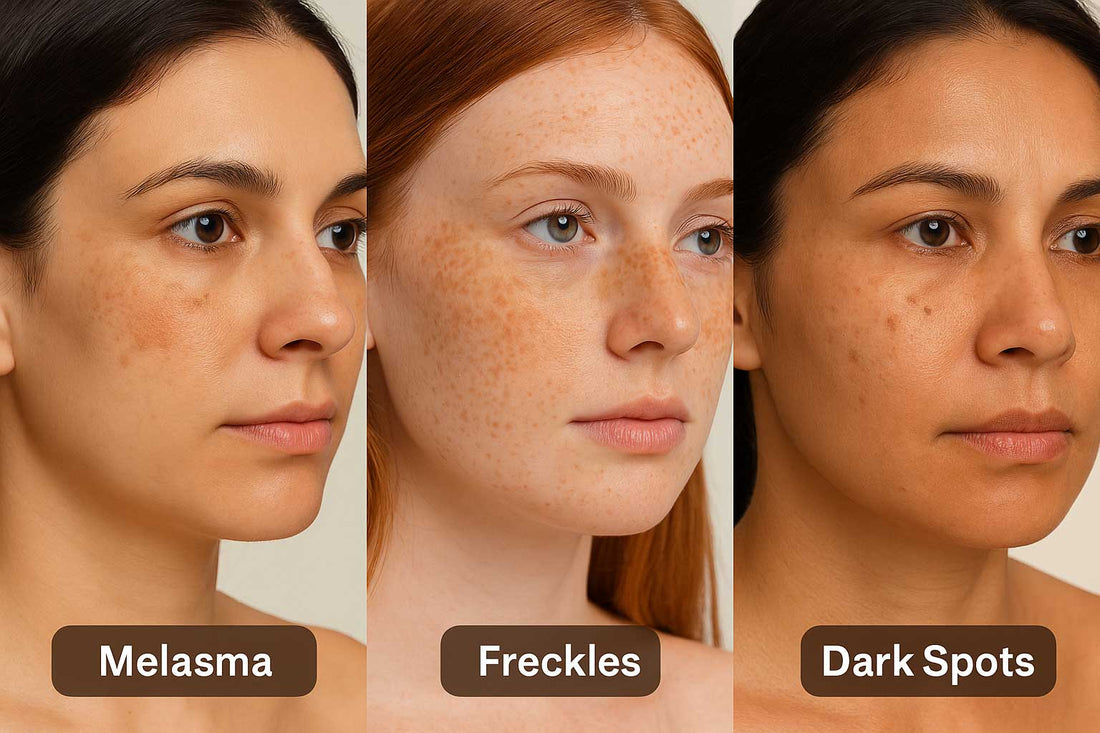
Have you ever noticed patches of skin that look darker than the rest of your face? Sometimes they’re small brown dots on the nose, sometimes bigger patches on the cheeks or forehead, and sometimes scattered spots left behind after a breakout. These are all types of pigmentation, but not all pigmentation is the same.
The most common ones are melasma, freckles, and dark spots. People often confuse them because they may look alike, but they’re actually very different in terms of cause, appearance, and treatment. If you’ve been wondering which one you’re dealing with, this guide is for you. Let’s understand how melasma, freckles, and dark spots differ.

What is Melasma?
Melasma is a skin condition that shows up as brown or grayish-brown patches. It usually appears on the cheeks, forehead, nose, and upper lip.
Why does melasma happen?
-
Hormonal changes, especially during pregnancy (which is why it’s sometimes called the “mask of pregnancy”).
-
Sun exposure, which triggers extra melanin production.
-
Family history – if your parents had melasma, you might be more likely to get it too.
-
Hormonal medicines such as birth control pills.
How does it look?
-
Larger, uneven patches.
-
Usually symmetrical (appears on both sides of the face).
-
More persistent and harder to fade compared to freckles or regular dark spots.
Melasma isn’t harmful, but it can be frustrating because of how visible and stubborn it is.

What are Freckles?
Freckles are small, light-brown spots that show up mostly on the nose and cheeks. They’re not a medical condition but a skin feature.
Why do freckles happen?
-
Sunlight – freckles appear or get darker when you spend time outdoors.
-
Genetics – some people are naturally more prone to freckles.
-
Skin type – lighter skin tones often show freckles more clearly.
How do they look?
-
Tiny, flat spots.
-
They get darker in summer and lighter in winter.
-
Usually harmless and often seen as a natural, even charming feature.
If you prefer to keep them lighter, the key is sun protection.

What are Dark Spots (Hyperpigmentation)?
Dark spots, also known as hyperpigmentation, are areas of skin that turn darker after damage or irritation.
Why do dark spots happen?
-
Acne marks left behind after pimples heal.
-
Sun damage over time.
-
Aging, often called “age spots.”
-
Injuries like cuts or burns that heal with leftover pigmentation.
How do they look?
-
Flat, brown spots that can vary from light to dark.
-
Appear on both the face and body.
-
Usually smaller and more scattered compared to melasma patches.
Dark spots are extremely common and can fade with consistent care.
How Melasma, Freckles & Dark Spots Differ
The easiest way to tell them apart is by looking at their size, cause, and behavior.
-
Melasma shows up as larger brown or gray patches, often linked to hormones and sun exposure, and it’s usually more stubborn.
-
Freckles are small, light-brown spots that appear and darken with sun exposure, and they’re mostly genetic.
- Dark spots are flat brown marks that come from acne, injuries, or sun damage, and they can fade with the right care.
How to Manage Them
For Melasma
-
Daily broad-spectrum sunscreen.
-
Use safe pigmentation creams.
-
Consider professional treatments if needed.
For Freckles
-
Focus on prevention with sunscreen.
-
Lightening products can help, but freckles often return with sun exposure.
For Dark Spots
-
Use brightening products with niacinamide, vitamin C, or alpha arbutin.
-
Gentle exfoliation speeds up fading.
-
Stay consistent, results take time.
Common Questions About Pigmentation, Freckles & Dark Spots
Are melasma, freckles, and dark spots dangerous?
No, they’re all harmless. But if you notice a spot changing shape or color quickly, it’s best to see a dermatologist.
Can melasma be cured permanently?
Melasma can be controlled, but it may come back with sun exposure or hormonal changes. The goal is to manage it.
Do freckles fade with age?
They can become lighter as you age, but sun exposure can keep them visible.
How long do dark spots take to fade?
Usually, 2-4 weeks with the right skincare routine. Severe spots may take longer.
What ingredients are best for pigmentation?
Safe and effective ones include niacinamide, alpha arbutin, kojic acid, and vitamin C.
Bebo & Co Skincare: Effective Solutions for Melasma, Freckles, and Dark Spots
At Bebo & Co, we know how frustrating pigmentation issues can be. That’s why our products are designed to tackle melasma, freckles, and dark spots safely and effectively. All our formulations are certified, free from mercury and steroids, and backed by science.
Some of our best solutions include:
-
Flawless Tone Pigmentation Cream – Targets melasma, freckles, and stubborn dark spots. Balances uneven skin tone and brightens dull areas.
-
Brita Glowing Face Wash – Cleans gently while supporting clearer, glowing skin.
-
Daily Sunblock SPF 60 – Protects against UV rays and prevents new pigmentation from forming.
When combined in a daily routine, these products can make a visible difference in the appearance of pigmentation.
So, briefly describing; Melasma, freckles, and dark spots may look similar, but they’re actually quite different in their causes. The good news is, with the right skincare habits and safe, effective products, you can manage all three and enjoy healthier-looking skin.
At Bebo & Co, we believe in simple, purposeful skincare that delivers results without compromising on safety. If pigmentation has been bothering you, remember—you don’t have to live with it. With consistent care and the right products, clearer and more even-toned skin is within reach.

